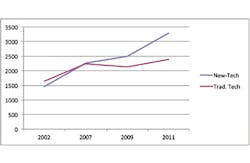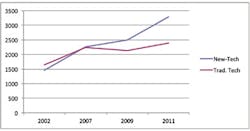A decade dominated by the rise of new-technology flowmeters
My market research career began in 1991 after a decade spent as a technical writer at an insurance company, a computer maker and Siemens. At Siemens I wrote guides and manuals for their PLC training courses. That ended when the Siemens division in Danvers, Mass., was moved to Alpharetta, Ga.
Technical writing hadn’t required original research and it was highly structured. Instead, I took market research jobs writing about multiple topics, such as barcode, test and measurement, process control and nondestructive test equipment. Market research was far more interesting and challenging than technical writing.
Since 1993, after landing a contract with Find/SVP to write a worldwide study of the flowmeter market, flow and instrumentation have been the main focus of my work. As mechanical and electronic sensors, today’s flowmeters are part of a range of technology advances that emerged in the post World War II era, with consequences not just for the process industries but for computer science in general and for studies in artificial intelligence and even the philosophy of mind.
I have been writing more or less continuously about flow and instrumentation since 1993.
Flow Research was founded in 1998, exclusively devoted to flow, temperature, pressure and other related instrumentation topics. Following several temperature studies, we systematically published research on every commercially available flow technology. A study of all flowmeter technologies worldwide in a single volume first appeared in 2002.
In studying flowmeter markets, we found most flowmeters fell into one of two groups: the “traditional,” that have been around and studied for 50+ years, and the “new-technology” flowmeters introduced in the second half of the 20th century. We later added an “emerging technology” category for flowmeters developed in the past 20 years.
What is generally true of traditional meters is that they are mechanical and intrusive. In many cases they have moving parts. Accuracy is generally less than that of new-technology meters. Traditional technology meters include differential pressure, positive displacement, turbine, open channel and variable area.
New-technology flowmeters, introduced since 1950, are minimally intrusive, are generally electronic and have higher accuracy and reliability than traditional meters. They tend not to have moving parts. They include Coriolis, magnetic, ultrasonic, vortex and thermal. Thermal flowmeters were originally classified as traditional meters but were reclassified in 2003 as new-technology flowmeters after extensive discussions with thermal flowmeter suppliers.
Flow Research has since published three more editions of “Volume X: The World Market for Flowmeters.” It is instructive to compare results of the four studies. They vividly demonstrate how new-technology flowmeters have gained market share from traditional meters over the past 10 years. The chart below shows the percentage of total worldwide revenues made up by new-technology vs. traditional technology flowmeters in the four years for which the studies were done. During this 10-year period, new-technology flowmeters have gained about 10 percentage points, while traditional meters have lost about 10 percentage points. None of these figures includes residential meters.
Why do new-technology flowmeters continue to gain share of the worldwide flowmeter market? There are many reasons for this, but here are some of the strongest:
1. New-technology flowmeters are typically more reliable over time than most traditional technology meters. This is because they are minimally intrusive and do not have moving parts. Manufacturers have put a lot of effort into improving their reliability.
2. New-technology flowmeters are typically more accurate than traditional meters. Coriolis and multipath ultrasonic flowmeters are the most accurate meters made. As the prices of fluids measured rise, particularly petroleum liquids, accuracy becomes more important.
3. More research and development work is being done on new-technology meters than traditional meters. Coriolis and ultrasonic suppliers have brought out a steady stream of new features and products over the past five years, while less development is being done on primary elements, positive displacement meters, or variable area meters.
4. New-technology meters are the subject of conferences where technical papers are read and discussed more often than are traditional meters. Colorado Engineering and Experiment Station, Inc. (CEESI) conducts one or more ultrasonic flowmeter workshops every year. Coriolis, ultrasonic and multiphase meters are discussed at the North Sea Flow Workshop in Norway and Scotland. The Flow Measurement Forum held in Perth, Australia, in November 2012 focused on flowmeters used in the energy industry, especially Coriolis and ultrasonic. Positive displacement, differential pressure (DP) and variable area meters are simply not getting the same mindshare as Coriolis and ultrasonic meters. As an emerging technology, multiphase meters are the subject of considerable interest.
5. Much of the growth in the flowmeter market is driven by growth in the energy industries, especially oil and gas production. Here differential pressure and turbine meters have an advantage in gaining early approvals for custody-transfer applications. But since 1995, multipath ultrasonic meters have been gaining custody transfer approvals for both liquid and gas applications. And in the past 10 years, Coriolis meters have also gained these approvals. This has enabled ultrasonic and Coriolis suppliers to compete effectively with differential pressure and turbine suppliers for the highly valued custody transfer market.
Will the future resemble the past? Expect the trend toward new-technology flowmeters that has been established over the past 10 years to continue. However, the picture is likely to become more complex as emerging technologies begin to make their presence felt. Multiphase flowmeters are having a major impact in the oil and gas market. Other emerging technologies such as optical and sonar are effective, but have yet to gain wide adoption. Of course, it is also possible that someone will come up with a completely novel way to measure flow and reshape the existing flowmeter market.
Jesse Yoder, Ph.D., is president of Flow Research, Inc., a company he founded in 1998. He has 26 years of experience as an analyst and writer in process control. Dr. Yoder specializes in flowmeters and other field devices, including pressure, level and temperature products. He has written over 150 market research studies in industrial automation and process control and has published over 200 journal articles. He recently authored Volume X: The World Market for Flowmeters, 4th Edition (www.floweverything.com).

